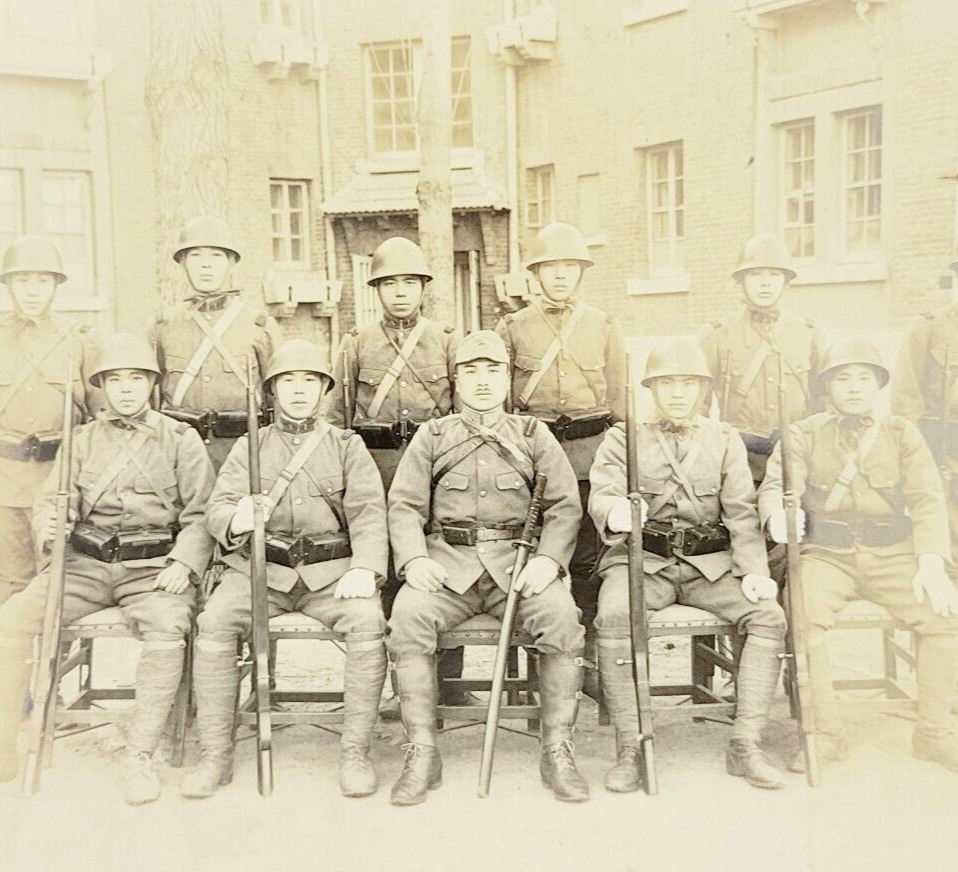|

On eBay Now...
c1935 Original Japanese Army Photo Officer and Squad Anshan Manchuria China For Sale

When you click on links to various merchants on this site and make a purchase, this can result in this site earning a commission. Affiliate programs and affiliations include, but are not limited to, the eBay Partner Network.

c1935 Original Japanese Army Photo Officer and Squad Anshan Manchuria China:
$499.99
This photo depicts the officer and squad of the Japanese Army who occupied Anshan in Manchuria, China.
Approximate size: 5.9 inches x 4.2 inches
The way this photo was developed gives the soldiers on the left and right side a \"ghostly\" effect. This is coincidental, but it gives the photo more mystery to it, along with a sense of art along with the historical value. Some consider the \"ghostly\" effect in antique photos quite valuable.
The Empire of Japan\'s Kwantung Army invaded Manchuria on 18 September 1931, immediately following the Mukden Incident. At the war\'s end in February 1932, the Japanese established the puppet state of Manchukuo. Their occupation lasted until the success of the Soviet Union and Mongolia with the Manchurian Strategic Offensive Operation in mid-August 1945, towards the end of the Second World War.
The South Manchuria Railway Zone and the Korean Peninsula had been under the control of the Japanese Empire since the Russo-Japanese War of 1904–1905. Japan\'s ongoing industrialization and militarization ensured their growing dependence on oil and metal imports from the US. The US sanctions which prevented trade with the United States (which had occupied the Philippines around the same time) resulted in Japan furthering its expansion in the territory of China and Southeast Asia. The invasion of Manchuria, or the Marco Polo Bridge Incident of 7 July 1937, are sometimes cited as alternative starting dates for World War II, in contrast with the more commonly accepted date of September 1, 1939.
With the invasion having attracted great international attention, the League of Nations produced the Lytton Commission (headed by British politician Victor Bulwer-Lytton) to evaluate the situation, with the organization delivering its findings in October 1932. Its findings and recommendations that the Japanese puppet state of Manchukuo not be recognized and the return of Manchuria to Chinese sovereignty prompted the Japanese government to withdraw from the League entirely.
Anshan is an inland prefecture-level city in central-southeast Liaoning province, People\'s Republic of China, about 57 miles south of the provincial capital Shenyang.
From 1918 to 1945, Anshan was under Japanese colonial control and was a center for modern iron and steel production. After the Mukden Incident in 1931, Japan occupied the northeast of China. The mills were turned into a Japanese-owned monopoly. In 1933, the site was expanded to include steel production and the company was renamed Showa Steel Works.
Anshan became part of the Japanese puppet state of Manchukuo. Additional industries developed around the iron and steel mills. Anshan grew significantly in size around this new industrial site, becoming one of, if not the largest producers of iron and steel in Asia. It was therefore of strategic importance in the Pacific War, and was subject to several attacks by B-29 Superfortress strategic bombers of the USAAF. The Japanese Army detached the 1st Chutai (unit) of the 104th Sentai (squadron) of the Imperial Japanese Army Air Force, to Anshan, with other air squadrons for industrial defense purposes.
Although this unit was equipped with modern Nakajima Ki-84 Ia (Manshu Type) Hayate \"Frank\" fighters, manufactured by Manshūkoku Hikōki Seizo KK, the plant suffered heavy damage from the air raids, losing up to 30% of its capacity.
After the war in Europe ended, the Soviet Union declared war on Japan, as the Red Army simultaneously launched Operation August Storm. Soviet forces advanced rapidly and soon captured much of Manchuria from the Japanese. In late 1945, the Soviet Red Army occupied a large amount of Liaoning and took major portions of the area\'s manufacturing and mining equipment to the Soviet Union.
With the defeat of Japan in 1945, Anshan was returned to China along with the rest of the Chinese Manchuria.
Please inspect the pictures, as they give the best representation of condition.May have discoloring, edge or corner wear, marks, creases, fading, smudges, corner or edge bends, tears, or corners missing.
(C25 inventory number)


Rare c1935 Original Japanese Navy Photo Machine Gunner Class Yokosuka Japan $299.99

c1935 Original Japanese Navy Military Group Photo Troops Headbands Sasebo Japan $299.99

c1935 Original Japanese Army Photo Captured Bandits Anshan Manchuria China $299.99

c1935 Original Japanese Navy Military Photo Petty Officers Submarine Badges $149.99

c.1935 Original Photo Fleet Air Base Coco Solo Canal Zone Panama ~Ia174 $24.95

c.1935 Original Photo USS Oglala CM-4 Navy Ship 2x4 ~Ia131 $24.95

c1935 Original Japanese Navy Photo Type 11 LMG Land Warfare Training Yokosuka $99.99

c1935 Original Japanese Navy Military Photo Naval and Merchant Officers Sasebo $199.99
|